A Beginner's Guide to Kitesurfing
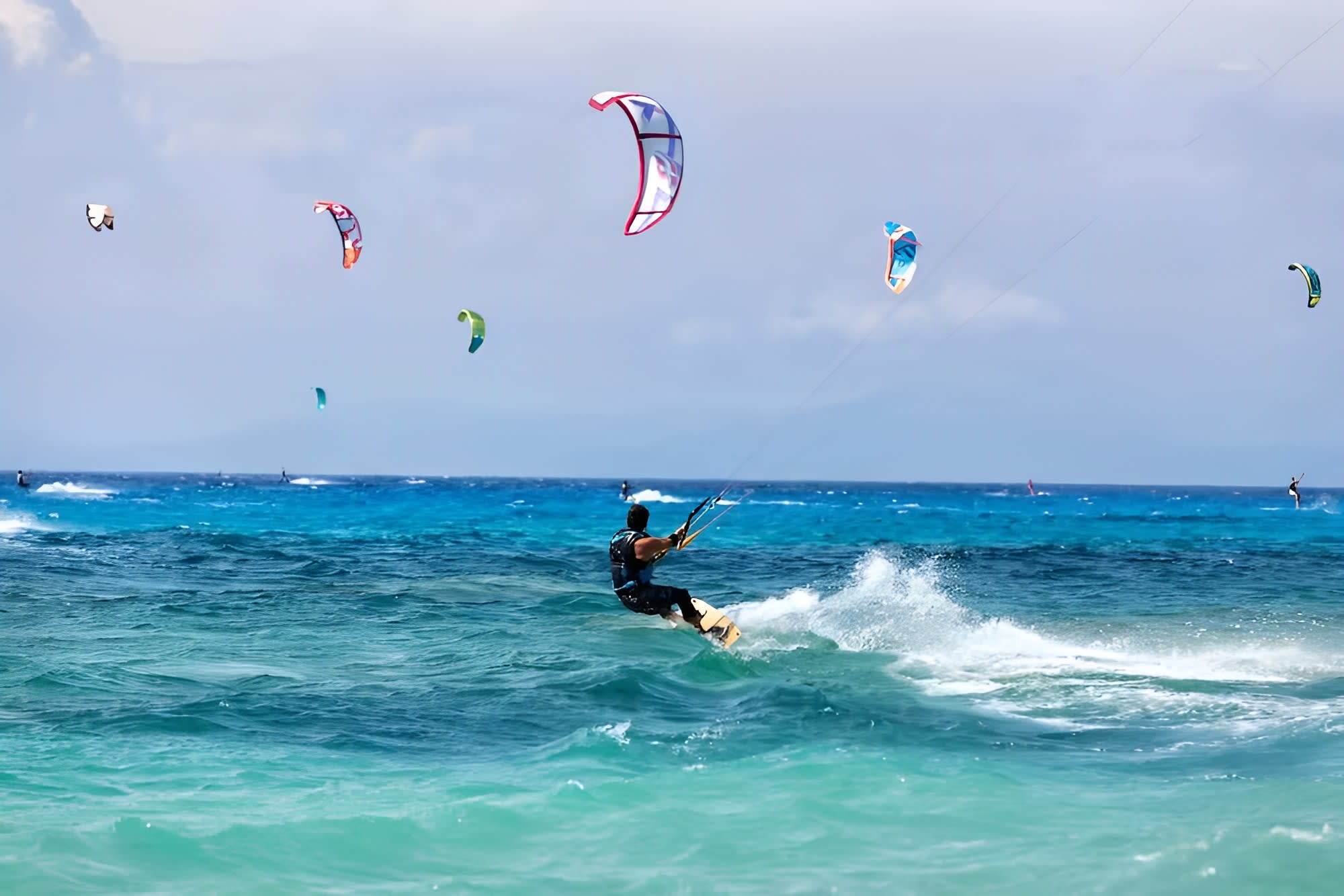
Have you ever dreamed of flying over the water? Or perhaps you saw the photos of Barack Obama kiting, and told yourself “Yes I can”! Or maybe you already did some kitesurfing, but it was a long time ago, and you want to be sure you remember the important points before getting back on the water. Whichever it is, this beginner’s guide to Kitesurfing answers all your questions about this exciting water sport.
Kitesurfing, also known as Kiteboarding, is a sport practiced by young and old, beginners and confirmed riders. One of the most beautiful aspects of this water activity is that you’re close to nature, especially the two elements water and wind. It is therefore important to understand the wind, to know what to do in critical situations, and what equipment to use.
All these topics and many more are addressed in this complete guide to kitesurfing and will give you an exhaustive picture of what kitesurfing is about and why you should absolutely try it. In the end, we will share our favourite spots with you! Are you ready to become a rider?
What is Kitesurfing?
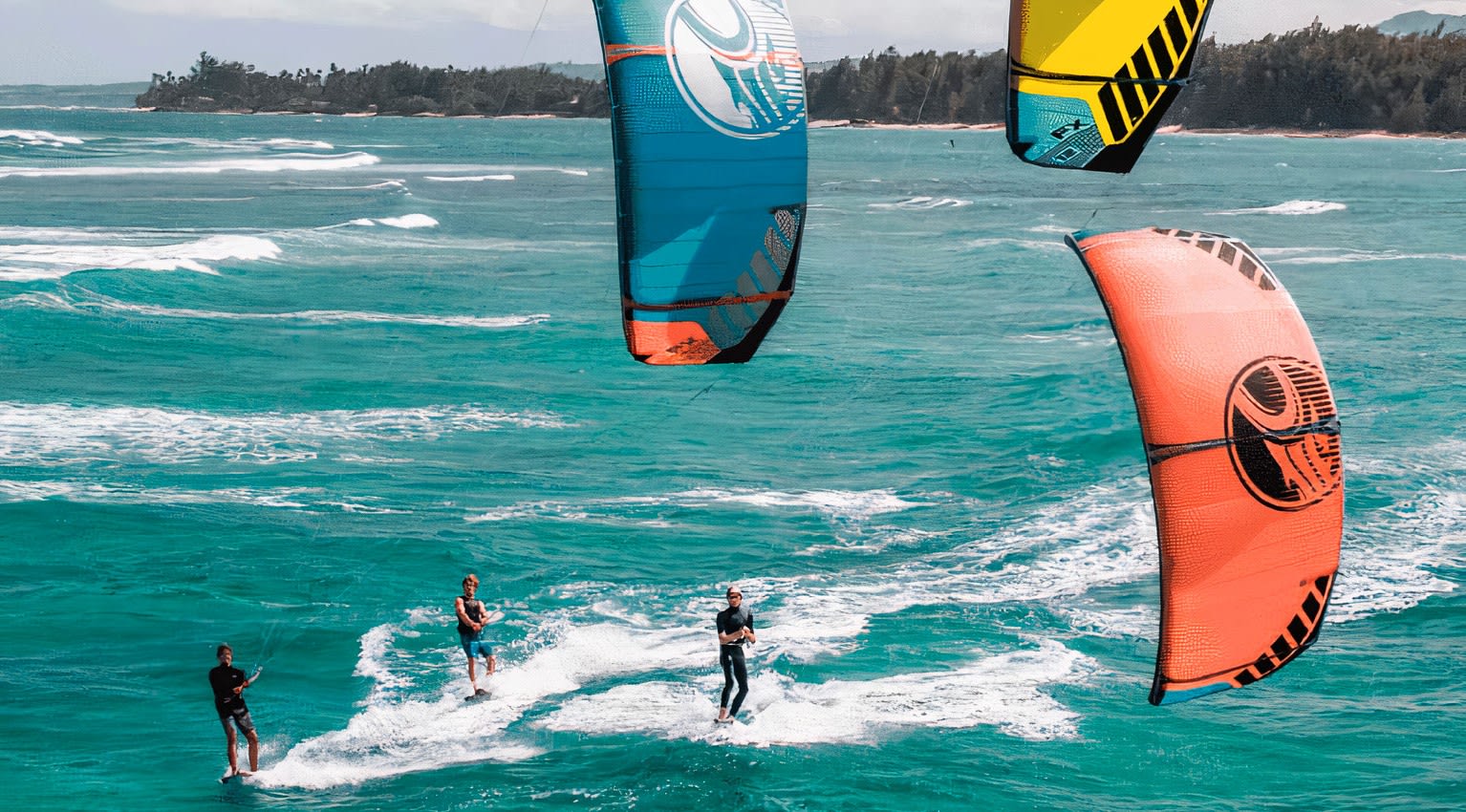
Over recent years, this individual sport has become more and more popular. But what exactly is kite surfing? It’s quite simple actually: with a kite attached to you and a board on your feet, you are using the wind to glide on the surface of the water.
Kitesurfing is a sport which, as you will see, allows you to progress quickly and that can be practiced in a wide variety of conditions, both in terms of the weather and the equipment used. This water sport is practiced in some stunning locations worldwide and can make an unforgettable holiday or group experience.
Moreover, kitesurfing is an accessible sport that welcomes everybody with a minimum age, sometimes, as young as 7 years old. The diversity of kiter’s personas within the sport is remarkable. Contrary to popular belief, kiteboarding is not only attracting big athletes and adrenaline junkies but also people of all ages and abilities, from kids to grown-ups, mothers, fathers, grandparents, people with physical disabilities, doctors, bankers, presidents, and become pretty much addictive to anyone who tries it. Most beginners are completely new to board sports, water sports, or the use of a sail.
What are the different forms of kitesurfing?
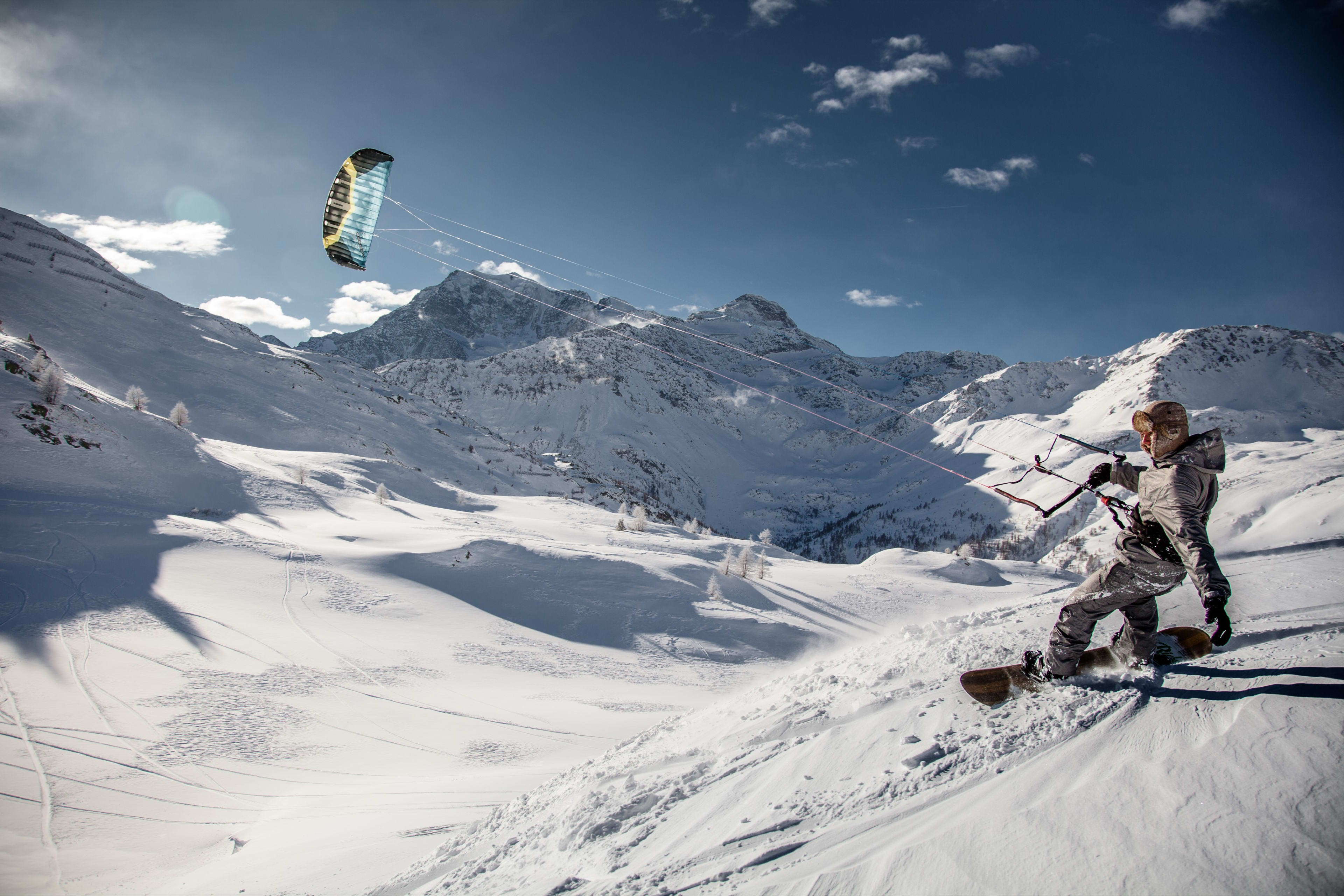
Kiteboarding has evolved a lot in the past decades and the sport is divided into multiple disciplines: wave riding, foiling, freestyle, slalom/course, speed, big air, wake park riding, kite buggying, and kite landboarding. There are various types of kites, different types of boards, and multiple combinations for each riding style and situation. Once you’ve reached an independent level in kitesurfing, you can try and see which of the above discipline you like most.
In addition to this, if you are a kitesurfing lover, or you tried kiting, but you didn’t enjoy it on the water, you can now perform this outdoor activity on land by doing mountain boarding or snowkiting. On the snow with a pair of skis or a snowboard, uphill, downhill, or straight across, you just need a bit of wind to experience this thrilling activity!
As a new sport, snowkiting is constantly evolving. Many snow kiters are playing around on frozen lakes, but others are pushing the boundaries with multi-day expeditions in the backcountry, endurance racing, and even cliff jumping. Just as skiing and snowboarding continue to evolve, snowkiting will surely continue to grow in the years to come. Needless to say, it’s an exciting time to be a snow kiter. But in this guide to kitesurfing, we focus on the water element, so back to water now…
Why learn to kitesurf?

There are several good reasons why you should try kitesurfing. First, for those who love travelling, this sport becomes an ideal counterpart. Kitesurfing opens up a new world of incredible travel destinations. It gives you the opportunity to explore new places and for some, far away from the tourist spots and close to the local life. Kitesurfing will also remind you of the beauty of nature and fosters your respect for the sea and the environment.
Moreover, kitesurfing includes you in an amazing community of interesting and fascinating individuals coming from around the world. Especially for people travelling alone, kitesurfing is a great opportunity to meet new people who share the same passion and teach you about their culture.
Secondly, kiting is good for your mental health. Practicing an outdoor activity in the sun gives you a good portion of vitamin D, the vitamin that fights diseases, reduces depression, and boosts weight loss. Practising any kind of sports promote the secretion of endorphins called the happiness or love hormones. These proteins help us to be happy and the shot of adrenaline you get from kitesurfing is the perfect stress relief and will benefit your mental health.
On top of all of that, kiteboarding helps you to get the summer body you’ve always wanted. While you are kitesurfing you build up strength in your abdominal area which will obviously have its effects on your general shape. But also being focused on multiple tasks simultaneously, increases your concentration and coordination while riding the board and improves your balance at the same time. In addition, this sport can boost your self-confidence. As your strength, skills, and stamina increase through practicing kitesurfing, your self-regard will improve as well.
And last but not least, with kitesurfing you will discover what Leonardo Da Vinci was always looking for, flying! Nothing can beat the feeling of endless freedom, adrenaline, connection with nature, and the pleasant ease of flying over the world with your board.
Should you not yet be convinced by our arguments in this guide to kitesurfing maybe these 10 reasons why you should start kitesurfing will change your mind.
What equipment do I need for kitesurfing?

With kitesurfing, the equipment is essential! It’s important that your school has good and not too old equipment because there have been some big improvements regarding safety in recent years. They should offer you a range of kites, boards, and safety equipment suited to your needs. They must also be able to provide you with equipment suitable for more intense wind conditions. During your lessons, you will need:
- Board
- Helmet
- Life jacket
- Kite: the kite is the wing that will pull you and help you to ride on the water, there are different forms and sizes of kites according to the wind and the style that you are practicing
- Bar: most of the time the bar has 4 or 5 lines that are connected to the kite and allow you to steer the kite to the right or to the left (and to move to the left or to the right)
- Harness: there are two types of harnesses. First, the seat harness, often chosen by kite schools for beginners as it sits lower than a waist harness, with the main body of the harness around the kiter’s hips. Second, the waist harness, which does not have leg straps and is better for jumping.
- Safety Leash: the safety leash for the harness is one of the most important pieces of equipment you should have! Not part of the harness, the leash is connected to your harness and the bar at your so-called chicken loop. It’s a safety system that is essential and that your kite instructors will explain to you in detail.
- Wetsuit: depending on the water and air temperatures you will want to wear a wetsuit to be comfortable. Check with your school in advance if they provide it (this is often the case).
As soon as you feel confident with the navigation of the kite on land, you will get your board and be ready to make your first meters on the water. And soon maybe your first jumps, who knows?
Who can learn kitesurfing?
As mentioned earlier in this guide to kitesurfing, contrary to what people might think, kitesurfing is accessible to almost everyone and not only to high-level athletes.
There is a minimum age, however. Depending on the school, it can be as young as 7 years old. Minors under the age of 14 years will need to be accompanied by a parent/guardian, and those under 18 years old will need a parent/guardian’s written permission.
When it comes to physical condition, all participants must be able to swim and must have at least a minimum level of fitness. You don’t have to be a crazy fit superhuman and have a lot of strength to control a kite. A kite is not heavy and is attached to your harness, so there is no need to build up muscles accordingly. However, a good level of general fitness will help you to progress faster, will give you more stamina on the water, and avoids injuries.
Practicing other similar board sports (snowboarding, wakeboarding, skateboarding, sailing, windsurfing, surfing, etc.) can also help you to progress faster.
How to learn kitesurfing?

Probably the most interesting question we want to answer in this complete guide to kitesurfing is how to learn to kite surf.
There’s no miraculous technique… Beginner lessons are essential for people who want to learn to kitesurf safely and properly. In addition to helping you to get up on the board, a good instructor will provide you with indispensable safety know-how and procedures. Without this knowledge, you are a danger to yourself and to others, whether on the water or on the beach. During the course, you will learn which kite to choose compared to the wind and to detect all the potential dangers on the beach that you have to take into account.
Before starting a kite session, it’s important to check the weather conditions, the tides, and the spot. You can go on dedicated websites like Windguru or Windfinder to check the forecast and to know which wind conditions await you for the day. It is strongly recommended not to go kiting in rough weather or when a strong wind is announced. We say it’s kiteable from 12 knots (22 km/h) to 30 knots (55 km/h) for beginners, with more than 30 knots of wind you put yourself in danger.
When arriving at the spot and before starting your lesson, it is important that you quickly inspect the spot and the wind direction to identify the potential dangers and to minimize your risk (swimming area/kite zone, reefs, currents, boats, buoys, wind condition, rescue service…).
What will I learn during my first kite lesson?
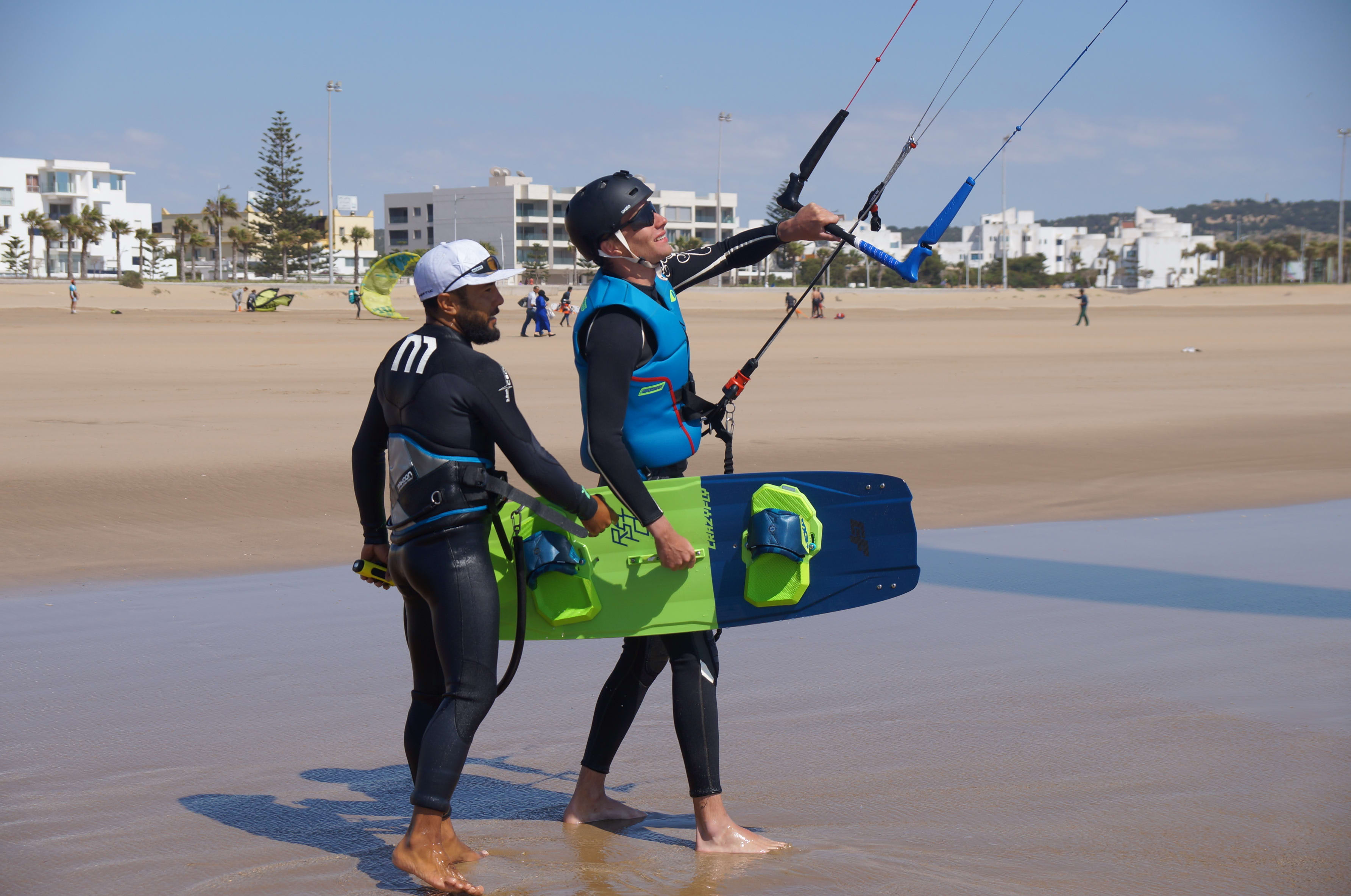
To start, the teacher will introduce himself and will ask you to introduce yourself. The first thing you will learn is to understand how the wind works (where the wind comes from, what is a good wind for kiting, what is the wind window, where can you make the kite fly, etc.), how a kite works, what are the three safety system (see below), what are the potential danger on a spot, what means upwind and downwind…
After understanding these important points, it’s time to take hands-on the kite. You will learn how to have good control of your kite with some little exercise. After that, the instructor will give you some exercise in the water with the kite (body dragging, control, and re-launching). When the instructor sees that you have good kite control and that you succeed in all the exercises you will learn how to do a water start (with the board of course).
What are the three safety information?
While you are kiting it can happen that you lose control of the kite for multiple reasons. There are 3 steps to follow in the right order if something like this happens to you. During your first lesson, your guide will explain these 3 steps that can save your life. We decided to quickly mention them in this guide to kitesurfing.
- The first safety step to take is to let go of the bar completely, the kite will drop into the water and 95% of the time stop pulling you.
- If the kite is still pulling you or starts to loop, you have to use the quick release which will open the chicken loop. You will still be connected to your kite with your safety leash, but the kite will lay on the water against the wind, so there is no power anymore.
- If the kite still pulls you because the release is blocked or the kite is stuck in the wave, in a tree, or in a boat, you have to release the safety leash. You will no longer be connected to your kite, and you can swim back to the beach.
Which are the best spots to learn kitesurfing?
This is the last, but nonetheless a very important question of our beginner’s guide to kitesurfing. Among the most famous places to kite, you’ll find destinations like Tarifa in Spain, Dakhla in Morocco, Cumbuco in Brazil, or Sotavento in Fuerteventura. But are those the best kitesurfing spots for beginners?
When you look for a spot to take your first lessons, it’s preferable to start in a spot with good wind and water conditions. A constant wind, not too strong but not too low, and flat water is the easiest conditions to learn and most enjoyable for beginners.
There are many ideal and beautiful spots to learn to kitesurf. Here is our top 5 selection for you.
Lake Garda, Italy
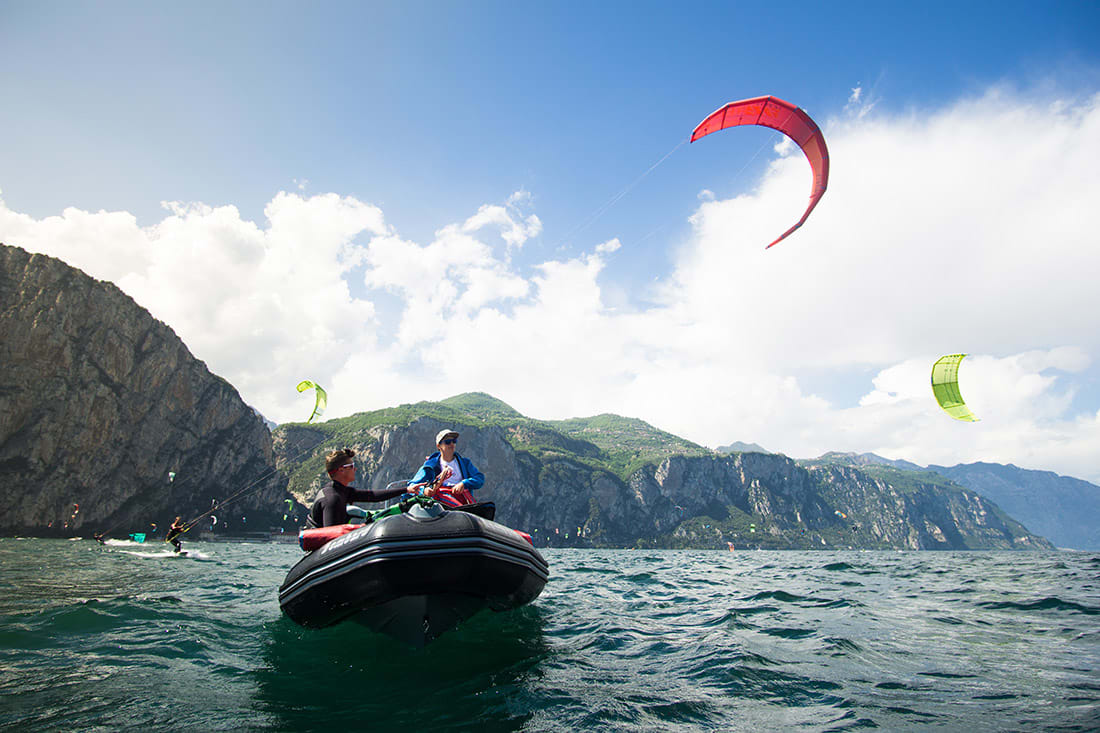
The largest lake in Italy is a popular holiday destination. Picturesque harbors, lively squares, quaint streets, beautiful beaches, and magical sunsets, that’s what await you on Lake Garda in the North of Italy. And despite the mountainous landscapes, you can feel the Mediterranean climate and the italianità.
More than that, it’s a perfect spot to learn to kitesurf. First, because it is one of the windiest areas of Europe and benefits from constant wind (from 12 to 35 knots) and flat, sometimes choppy water thanks to its location with the north wind in the morning and south wind in the afternoon – twice the opportunity to practice.
When kitesurfing on Lake Garda your experienced instructors will accompany you with a boat which can make you feel more secure and will allow you to avoid the walk of shame (that is walking back to point A with your kite…). Thanks to tailor-made training you can progress at your level, Beginner or Advanced, and choose from 1-day to 4-day lessons. The best period to go kitesurfing on Lake Garda is from mid-April to the end of September.
Costa Calma, Fuerteventura
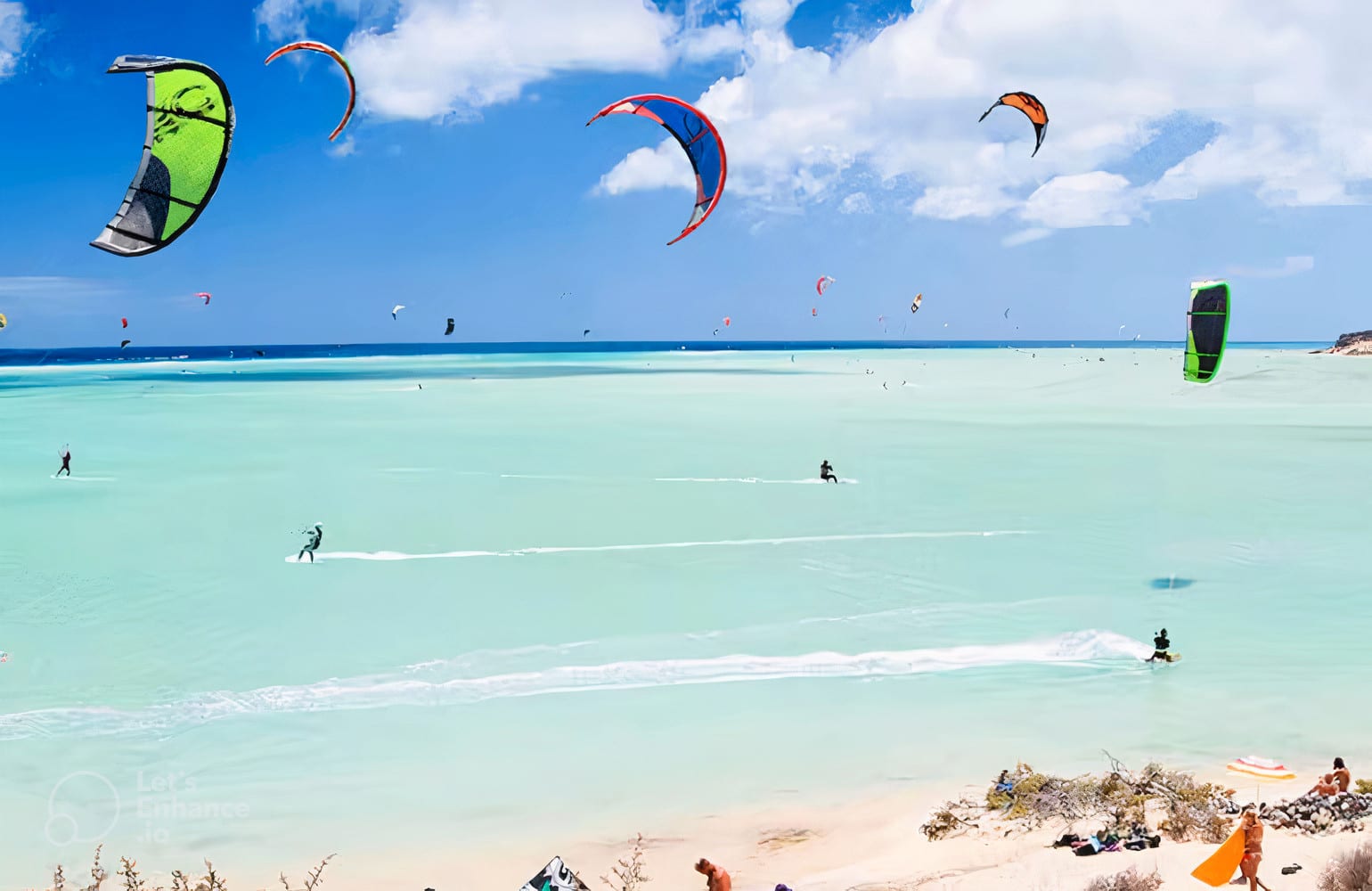
Our next great spot to learn to kitesurf takes us to the Canary Islands, more precisely to the island of Fuerteventura. With a pleasant climate throughout the year, Fuerteventura is a popular holiday destination at any time. In addition to diving, sailing, surfing, and windsurfing, kitesurfing has become more and more popular on the island in recent years. That’s why today you find many kitesurf schools in Fuerteventura.
Matas Bay is a beach at the Costa Calma in the southeast of the island. Thanks to its geographical position the bay is rarely affected by weather conditions and the water in the lagoon, therefore, keeps relatively flat. Perfect for beginners! More experienced kiters can try to go offshore where they’ll find strong winds and gusts.
During your kitesurf lessons at Costa Calma, certified kite instructors will teach you the navigation of the kite on land, introduce you to the first moves on water and teach you how to ride independently. The best period to learn to kitesurf on Fuerteventura is April to October.
Dakhla, Morocco
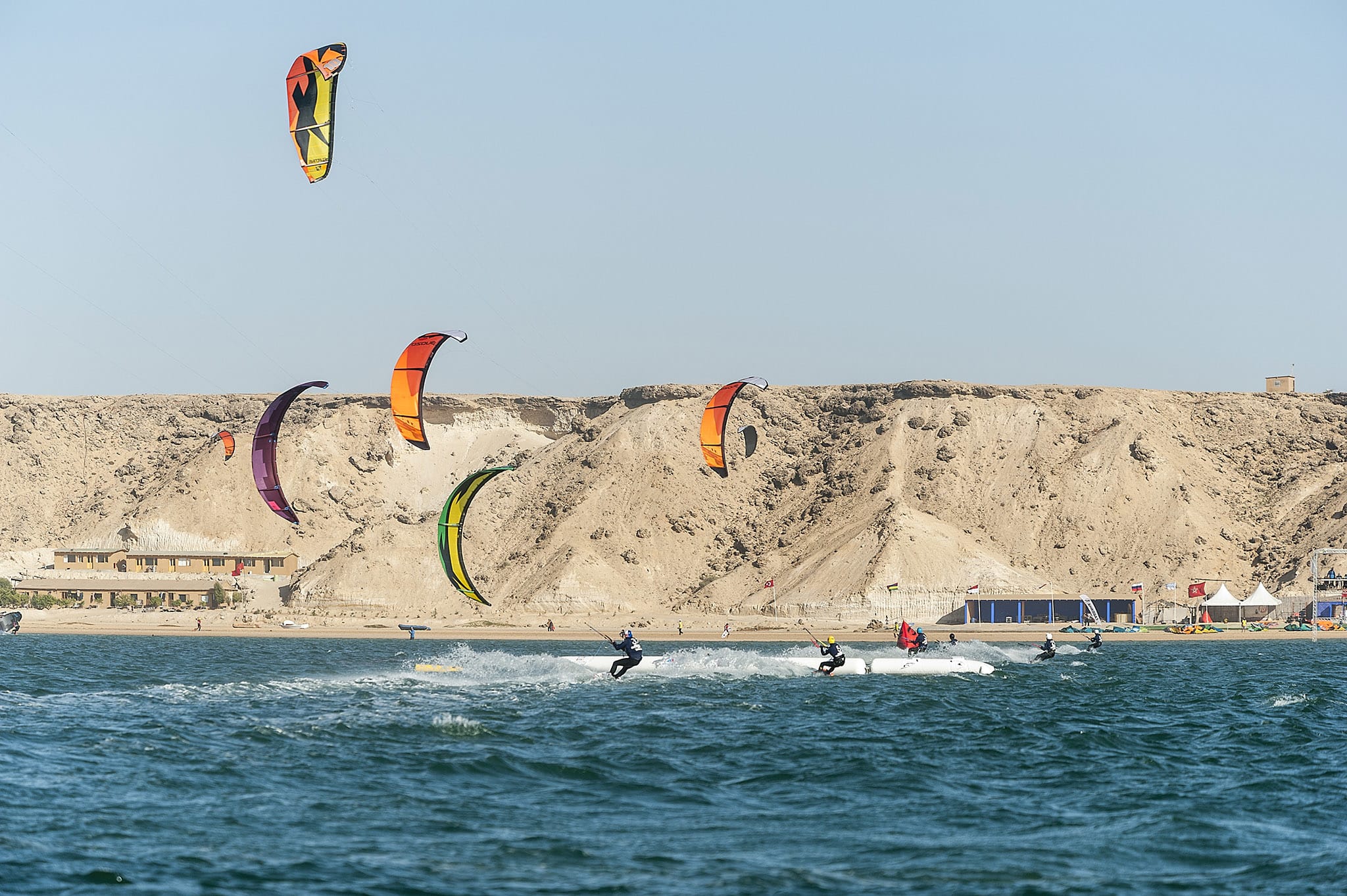
If you want to enter the world of kite surfing you won’t get around the name of Dakhla as it is a very famous spot for this sport. Located in Western Sahara on the east coast of Morocco, Dakhla is the country’s most southern city. The peninsula of Dakhla draws a giant lagoon, well protected from the wind thanks to the dunes. An ideal spot for beginners and indeed, in the last years, it has become a center for aquatic sports like kitesurfing, wake surfing, and surfcasting.
The best way to learn kite surfing in Dakhla is by booking a 1-week stay in one of the hotels you find right at the lagoon. Thanks to the many kite schools and kite instructors concentrated on that hot spot, you won’t have any problem finding the perfect lesson for you. From beginners to advanced, everyone will find its ideal formula. Many kite schools allow you to use their material even after the lessons, so you can practice for yourself.
Interesting encounters are guaranteed too! During your stay, you will meet kite lovers from all over the world. From April to the end of August you’ll find the best wind conditions in Dakhla. And if you need a break from all the kite surfing (you will have sore muscles!) how about a quad tour or a camel ride in the Sahara Desert?
Soma Bay, Egypt
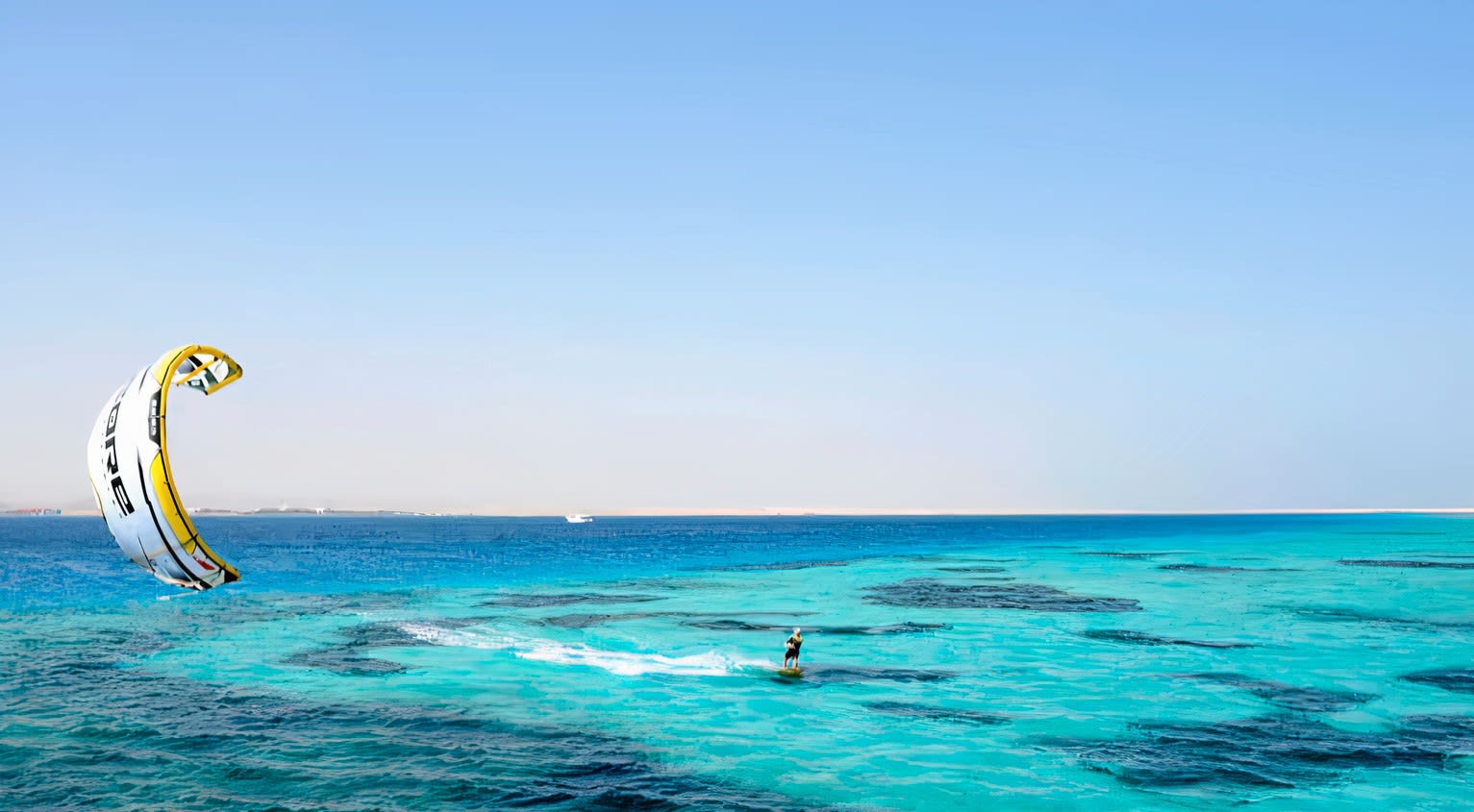
Another spot we can recommend you to start your career as a rider is Soma Bay in Egypt. This coastal resort on the Red Sea has the perfect conditions to learn to kitesurf: a beautiful crystal clear lagoon with flat, sometimes choppy water and constant wind as well as interesting offshore wind for the more experienced ones among you.
Unlike Tarifa, another very famous kiting spot in the south of Spain, Soma Bay offers a large coast to kite surfers. Every rider has more than enough space to practice without interfering with other kiters. And just as for Dakhla, many people come to Soma Bay for kitesurfing that’s why you’ll find a great number of kitesurf schools, hotels, and an entire kite community there. With specialized tour operators, you can book organized stays of several days including hotel nights, food, and kite lessons. Soma Bay is not only known for kitesurfing but also for its golf course.
Barra Grande, Brazil

On the other side of the Atlantic Ocean, on the coast in the northeast of Brazil, you’ll find the last (but not least) spot for beginners we want to share with you in this complete guide to kitesurfing. The Barra Grande is a beautiful place on earth with several kite spots, each with its own characteristics. You’ll find the best wind there from July to February, with particularly favorable conditions in autumn. Moreover, the water temperature is always around an amazing 30 °C!
Barra Grande offers a great frame for beginners with many kite schools being present and an enjoyable Brazilian vibe in the villages, home to many little restaurants and bars to treat you after a hard day of kite sessions. Most importantly, Barra Grande’s lagoon assures flatwater with the rising tide. With high tide, however, the water can get choppy. But don’t worry, your instructors will advise you on the best moment for your lessons.
Ready to fly over the water?
We hope that this beginner’s guide to kitesurfing has answered some of your most important questions about this exciting water sport and most importantly, that it makes you want to learn kiteboarding very, very much!
The above information helps you to get an understanding of what kitesurfing is all about. Nonetheless, lessons with a professional kitesurfing school are indispensable for every beginner as it is the only way to properly and safely learn this sport.
Have you already made up your mind about where you want to do your first kitesurfing experience? To help you decide, have a look at our over 180 kitesurfing activities or check out our dedicated article with the 5 top spots to learn kite surfing in Europe.